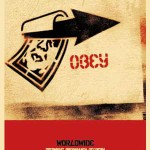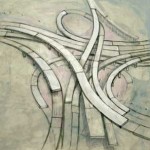With three years behind it, Gallery Katz is middle-aged by SoWa standards. Started by Drew Katz, a RISD grad originally from Kansas, this gallery showcases work that often stands out from the surrounding venues. And like his gallery, Katz himself is youthful and energetic, a mere 26 years old. Perhaps it is his age, or his energy, or his outgoing nature that inspired Big RED & Shiny to sit down with Mr. Katz to discuss his gallery, his artists, and the changing nature of SoWa.
BRS: I tend to think of you as a ‘new kid’ over here at SoWa, but the truth is that you have been around for quite a while compared to some. How do you see yourself and your gallery compared to some of the newer spaces, or those that have longer histories?
DK: I still feel like a new kid. People come in all the time who have been coming for years and they say ‘Are you new?’ and I have to say ‘No, I’ve almost been here for three years.’ I think that just my age, the way I look, people say ‘He’s just new or young or just starting out.’
This area is a real challenge. I think we all try to project success, we all look sharp and we have nice spaces, and I think its tempting for a young person to say that this is the right place to open a gallery. But it’s also really challenging at the same time. I mean, it’s a tough area to draw people and I hope that a lot of the younger galleries, I don’t mean younger in age just newer establishments, can get the hang of things and bring in their own crowd and their own type of people, and at the same time we all feed off the audience that comes to see the more established galleries. That’s sort of what the interaction between the galleries is all about.
BRS: How much interaction do you have with Bernie Toale (Bernard Toale Gallery) or Camilo (Alvarez of Samson Projects) or Randi and Beth (Hopkins & Kantrowitz of Allston Skirt Gallery)? Or do you all function independently, and find out what everyone else is doing at the openings?
DK: We all work on our own, we all function independently and we all have our own styles, but sometimes a client will come in and they’ll have a specific taste. I’ll bring them down the hall to Clifford-Smith to see a work or an artist that they might have. When you do group shows like this (Structure II), which I very rarely do, I borrow work from other galleries. That happens a lot, I think, in this building. But I might also go down to Newbury Street and borrow something from a gallery there. That’s sort of what the gallery world is all about. You might have some exclusive deals, but if there’s an artist you really want for a show you share and you work out deals, percentages…
In that sense, it’s really nice to be that close to so many galleries. If a consultant comes in, and they need a specific style or subject matter, I quickly have ten to twelve galleries that I can run to and just ask ‘What do you have in inventory that this consultant might see?’
BRS: Having a significant percentage of the galleries in Boston all in one place…
DK: (laughs) Are you trying to get at the competitive-ness of it?
BRS: (laughing) No, no. I was thinking of the bigger picture, which is that on one hand it seems that it’s really easy for an audience to be able to go to one place and see so much work. Can you talk about what you see as good or bad about a situation like that?
DK: The one thing I’ve learned about having a gallery is that there is no predictability whatsoever. When you think people are going to come, they usually don’t, and when you’re having a quiet Thursday afternoon you might get a dozen. It just doesn’t make any sense whatsoever.
So along those lines, sometimes I’ll hear footsteps going straight down the hall to Clifford-Smith or OH+T, and they’ll walk right back and pass the space. A lot of people have a specific agenda when they come here, and they’re not really interested in checking out what else is going on. On the other hand, from my perspective this is a great place because you can bring a class down, or you can bring your family down and spend two or three hours here easily, just checking out the diverse work and the range of contemporary art in Boston.
The negatives are minor. Obviously, if a collector comes in and they like something in my gallery and they like something in someone else’s, the fear is that they might choose to buy the other piece. But that’s deep deep down, I don’t feel that way most of the time. I think if somebody really likes something, really connects with something in the gallery then they’re going to go get it.
BRS: Going in a different direction: among the list of the recent shows you’ve had include the two Structure shows, Shepard Fairey and Todd Elliot. Can you talk about how you choose work for your shows, if you have certain collectors or audiences in mind, or is there some other guiding force?
DK: The whole point of having a gallery, especially naming it after yourself, is to let people know the type of work you like and choose to show. I can’t help but show the things that I really like, and that is a lot of print, a lot of architectural influenced images. Then I also try to do things like works on paper that are more affordable. One of the important things I try to look at with a show is ‘Can I afford something in my own show?’
The great thing about the Shepard Fairey show was having teenagers come in and buy work from me, which is really unheard of in the art gallery business. I mean, in New York, Boston, you don’t see an eighteen-year-old going into an art gallery and putting down money for a genuinely signed piece of art.
BRS: Do you see that as audience building? Are you looking toward when that eighteen-year-old is thirty-five?
DK: In the back of my mind, maybe. Obviously I want to grow with my audience, and although they might not be able to afford something now – if I am around in five or ten years, that will be the time when they have families and houses and a more secure lifestyle and they might come back and buy art. They might remember some shows they wished they could have purchased something when they were younger. It’s not really an objective, or something that is conscious, but I hope that happens. It’s a neat feeling to grow old with an audience like that.
BRS: I know you said you don’t do group shows very often, but the two Structure shows were group shows. Where do you find artists for your themed shows? What is your recruiting process?
DK: The Structure Show had a photography element, so I just did some postings and submission guidelines around local schools and on some photography websites. Things like that. We had a lot of submissions and we got to pick from a good selection.
This show (Structure II), I picked a lot of artists from New American Paintings. It’s a great source for collectors and dealers to put shows together like this. One of the reasons I wanted to do that came from the fact that many of these artists are represented by galleries and, as we touched on before, I think it’s important for galleries to work together.
It was fun to discuss with other galleries their artists and arrange for the work to be sent in for the shows. It’s a valuable experience.
BRS: At one point, you said that you consider your gallery a learning space.
DK: I always watch the show Scrubs and they talk about how it is a learning hospital. As much as I can I try to make this as open and as truthful and honest as possible when people have questions.
BRS: Looking at the overall Boston scene, the full spectrum, there is a part that is very non-commercial. I’m curious how often you go out to those spaces that are trying to be incubators, like the BCA or Art Interactive, and just look to see what ideas you can fold into what you’re doing here?
DK: That’s a tough thing for me. Besides the gallery, I work a full-time position someplace else. I’m out six days a week, between that space and my own space, and it gets frustrating because there are a lot of shows I want to see but there are only so many days a week that I can get around. And Sunday is not necessarily gallery day, no one is open.
BRS: Which seems weird to me.
DK: It depends on your location. I mean down here (in SoWa), I think Sunday is going to be dead no matter what. If you’re on Newbury Street… If I was on Newbury Street, I’d probably be open seven days a week. It’s easier for me to say it now than if I actually had a space and wanted a day off.
But it’s really just about location.
Anyway, I don’t make it to as many openings as I want. I try to go to as many as possible, but the truth of the matter is that we have a busy schedule, and I have a busy lineup, and I have particular artists in mind that I’ve found and want to work with.
BRS: So when you add new people to your lineup, they usually come to you?
DK: I’d say about 80% of the artists I show here have come off ‘domino effect’, especially from RISD. You show one artist, and they have a really close friend who they think their artwork is going to fit into the realm of Gallery Katz so they show me their work and then we hook up. It just tumbles on and on, and you sort of build this big web of artists that everyone knows each other. It’s sort of incestuous, everyone knows each other.
It’s hard to get out of that loop, that rut. I mean, I don’t only want to show RISD students or alumni, faculty… That’s not really the point, it just kind of happened that way. Submissions that come in are generally not to my liking. They just don’t fit the gallery, they don’t fit our style or what we do. I’m usually finding something or seeing something out there that’s been referred to me by someone.
BRS: What’s in the future for Gallery Katz? What’s in store for the next few shows, and where do you see yourself in maybe five years?
DK: I’ve got a painting show coming up – a girl who did industrial landscapes for her last solo show and her next show is along those lines. Jessica Hess. She paints very representational work. I love representational work. I’d say that I’ve shown ‘abstracted’ paintings, but overall everything has been representational and she’s sort along the lines of photo-realism.
Then, every May for my anniversary, I try to plan a furniture exhibition, which has been annual. The first two were great. For this third one I’m trying to set something up with furniture department at RISD. So I think that will be great, to bring, in a sense, RISD – the whole school, or a whole department – into the building, into Boston, and make our presence even more known.
In five years… you know, it’s hard to say. I had no idea where I was going to be a year from when I started. I’m taking it a month at a time, which doesn’t seem like a three-year plan or anything like that. I just try to consistently have shows that I like, and I think other people are going to like and appreciate. I want to make things affordable, and take things one step at a time.
The gallery is probably going to change shape, literally, in the upcoming months. We might change formats a little bit. The reason I say ‘it might’ is that I could change my mind at the last minute, and that’s the great thing about owning your own business. You can do whatever you want, and people constantly remind me of that. I’ll say ‘Oh, I have to do this or that, I have to have a group show’, and my girlfriend might say ‘Why do you keep saying that? It’s your gallery! If you don’t want to show sculpture, you don’t have to show sculpture.’
There were a lot of things, when I first started, that I thought I had to do. But there’s no template, there’s no format, and you just end up doing what comes naturally.
So it’s hard to say what’s going to happen in five years, because my own path in life has changed so much that it’s impossible to say what the gallery is going to do.
BRS: Going back to the question of whether or not all the SoWa galleries coordinate…
DK: Which I hope happens more often, by the way, as far as shows. I think it would be great for publicity, to have a unified theme throughout the building. But that’s easier said than done.
BRS: Do you have any plans for CyberArts?
DK: No. CyberArts is a great project, it does a lot for the city, but it’s not very marketable. The work involved is not very marketable, and as much as we’d like to show whatever we want, in whatever style we want… I mean, I’ve shown twelve-foot photographs that I knew wouldn’t sell but I loved the work, and I wanted to get it out there. But at the end of the month, you begin to think twice. As much as I like the work, I’m not going to be in business very long unless some of the work moves.
BRS: Any final thoughts?
DK: Well, I really enjoy my time here, and I enjoy the gallery and the people that come in and want to talk about art. So, final thoughts? I don’t know. I’m a twenty-something going through that time in life, trying to relate to other people around me. I’m not going to pretend that this gallery isn’t that.
- Todd Elliot, Big O’s, Acrylic on Polycarbonate.
- Shepard Fairey, Worldwide Delivery, Print on Metal.
- Christopher Santer, Sugar…, Acrylic on Canvas.
Links:
Gallery Katz
All images are courtesy of the artist and Gallery Katz.






